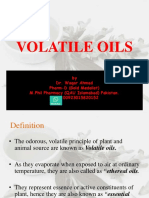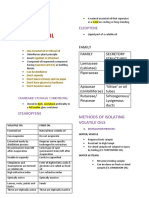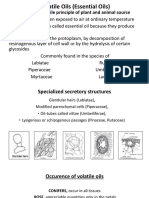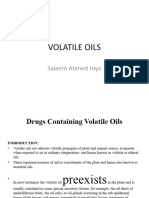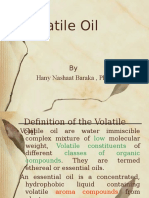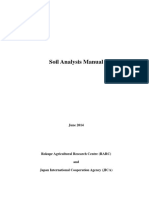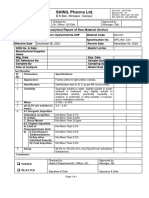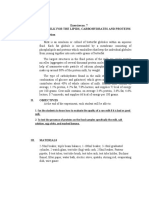7.
VOLATILE OILS NOTES BY BILAL MALIK
VOLATILE OILS
Volatile or essential oils, as their name implies. are volatile in steam
They differ entirely in both chemical and physical properties from
fixed oils. With the exception of oils such as oil of bitter almonds
which are produced by the hydrolysis of glycosides.
these oils are contained largely as such in the plant.
They are secreted in oil cells. In secretion ducts or cavities or in
glandular hairs.
They are frequently associated with other substances such as gums and
resins and themselves tend to resinify on exposure to air.
Volatile oils are sweet-smelling liquids, and they emit fragrance to the
food and are also slight bitter in taste. Thus, they help to enhance the
secretion of digestive enzyme in the alimentary tract
Volatile oils, when fresh, are colourless liquids. A few are crystalline or
amorphous solid.
On long standing, they become darker in colour, especially when exposed
to air and direct sunlight.
Volatile oil should, therefore, be stored in tightly closed amber-coloured
bottles in a cool, dry place.
Volatile oils are slightly soluble in water but are readily soluble in ether,
alcohol and most of organic solvents.
Volatile oil/ essential oil Fixed Oil
Volatile oil can evaporate when Fixed oils do not evaporate at
placed under room temperature room temperature
They can be extracted easily by They require some specific
the distillation process techniques for extraction.
207
� 7. VOLATILE OILS NOTES BY BILAL MALIK
There is no spot (no permanent Some type of spot (permanent
stain) left after evaporation stain) left after evaporation
They are unable to undergo
Fixed oils can be easily sponified.
saponification
Volatile oils are mixture of
hydrocarbon terpenes,
sesquiterpenes and polyterpenes Esters of higher fatty acids &
and their oxygenated derivatives glycerin are called as fixed oils.
obtained from various parts of the
plants
Posses high refractive index Posses low refractive index
These are optically active. These are optically inactive.
Their primary source is leaves, Their major source is seeds of the
roots, in petals and bark. plant.
CLASSIFICATION:
(a) Hydrocarbon volatile oils: Cubeb and Turpentine oil.
(b) Alcoholic volatile oils: Peppermint, Coriander and Cardamom.
(c) Aldehydic volatile oils: Bitter orange peel, Sweet orange peel, Lemon
Cinnamon and Bitter almond oil
(d) Ketonic volatile oils: Camphor, Spearmint, Caraway, Buchu
(e) Phenolic volatile oils: Clove, Thyme.
(f) Phenolic ether volatile oils: Fennel, Anise, Myristica.
(g) Oxide volatile oils: Eucalyptus, Chenopodium.
(h) Ester volatile oils: Rosemary.
(i) Miscellaneous volatile oils: Allium, Anethum.
208
� 7. VOLATILE OILS NOTES BY BILAL MALIK
a)HYDROCARBON VOLATILE OILS:
i) CUBEB
DEFINITION: Cubeb is the dried, full-grown, unripe fruit of Piper cubeba
Linn.
Botanical source: Piper cubeba
Family: Piperaceae.
Geographical Sources
Java, Penang, and other parts of East Indies
MACROSCOPICAL FEATURES:
A creeper or climbing perennial plant, with a bunch of dioecious flowers in
spikes.
Odour: aromatic and characteristic-
Taste: strongly aromatic and pungent and somewhat bitter.
Commercial cubebs consist of the dried berries, round in shape and looks like
black pepper, but with stalks attached – the "tails" in "tailed pepper". The dried
pericarp is wrinkled, and its color ranges from grayish-brown to black. The seed
is hard, white and oily
The stalked berries are slightly larger than black peppercorns, have a furrowed
surface and most are hollow. They are sold whole and should be crushed or
ground before use.
209
� 7. VOLATILE OILS NOTES BY BILAL MALIK
Constituents:
Volatile oil (10 - 18 %)
Resins
Amorphous cubebic acid
Colourless crystalline cubebin.
By extraction with ether yields oleo-resin (22%).
USES OF CUBEB:
Stimulant, carminative, aphrodisiac much used as a remedy for
gonorrhoea, after the first active inflammatory symptoms have subsided;
also used in leucorrhoea(Leucorrhoea: is a thick, whitish or yellowish vaginal
discharge. There are many causes of Leukorrhea, the usual one being estrogen
imbalance.), cystitis, urethritis, abscesses(An abscess (Latin: abscessus) is a
collection of pus that has built up within the tissue of the body. Signs and
symptoms of abscesses include redness, pain, warmth, and swelling. The
swelling may feel fluid filled when pressed) of the prostate gland, piles and
chronic bronchitis.
Cubeb was frequently used in the form of cigarettes for asthma, chronic
pharyngitis and hay fever
CUBEB OIL:
About 15% of a volatile oil is obtained by distilling cubebs with water
Monoterpenes:
• Sabinene 50%
• α-thujene
• Carene
Sesquiterpenes
210
� 7. VOLATILE OILS NOTES BY BILAL MALIK
• Caryophyllene
• Copaene
• α- and β-Cubebene
• δ-Cadinene
• Germacrene
Oxides 1,4- and 1,8-cineole and the alcohol cubebol.
CUBEB OIL – USES:
Cubeb essential oil is pungent, slightly camphorous, with a touch of nutmeg. It
has
Stimulant,
Expectorant,
Carminative,
Antiseptic, and
Diuretic properties
ii) TERPENTINE OIL:
• Syn Name: Oil of turpentine, Turpentine tincture, Turpentine spirit.
• B.O: Pinus Longifolia Roxb.
• Pinus roxburghii Sargent.
• Pinus excelsa Wall.
• Family: Pinaceae
COLLECTION:
• Pinus oleoresin is a normal i.e. physiological product of pine. The amount
produced is generally enhanced by injury or by treatment with 50%
H2SO4. It is secreted in plant tissues in specific cavities or resin ducts.
The cavities are themselves formed either in a schizogenous or lysigenous
fashion.
211
� 7. VOLATILE OILS NOTES BY BILAL MALIK
• These are anastinosing in nature. When one of the passages is open as in
wound from a distance. The acid treatment crumpled the thin walled
parenchyma.
• This permits the duct channel to become larger providing a more rapid
flow of oleoresin and two methods of collection have been used;
• 1. Box method.
• 2. Cup and gutter method
• CHARACTERISTICS:
• Turpentine oil is colourless liquid possessing a characteristic odour and
taste. It is soluble in alcohol and has a specific gravity of 0.854-0.868 at
25C.
• CONSTITUENTS:
• Turpentine consists of Dicyclic monoterpenes such as d & L a-pinene and
camphene. [Camphene induced apoptosis by the intrinsic pathway in
melanoma cells & exerted antitumor activity in vivo]
• It also contains monocyclic monoterpenes such as dipentene and methyl
carbachol and also bormyl acetate etc.
Uses:
Turpentine oil is now rarely given internally.
Externally it is used as counter irritant,
rubifaciant in lotions,
also as mild antiseptic.
It is also used as solvent for waxes in the production of
synthetic camphor, shoe polishes and furniture polishes.
b) OXIDE VOLATILE OILS:
a binary compound of an element or a radical with oxygen
i) EUCALYPTUS LEAF:
DEFINTION:
212
� 7. VOLATILE OILS NOTES BY BILAL MALIK
Eucalyptus leaf consists of the whole or cut dried leaves of the older
branches of Eucalyptus globulus, (Myrtaceae).
GEOGRAPHICAL SOURCES
Portugal, Spain, China, Brazil, Australia, India, Pakistan & Paraguay.
Eucalyptus – DESCRIPTION:
MACROSCOPICAL
• Older dried leaves are grey-brown & have lateral veins.
• Secretory oil cells are visible in leaves held to the light.
MICROSCOPIC
• Epidermal cells have a thick cuticle.
• Mesophyll has schizogenous oil glands
• Calcium oxalate crystals.
EUCALYPTUS OIL:
Eucalyptus oil is the volatile oil obtained by the distillation of the fresh leaves
of Eucalyptus globulus and other species of Eucalyptus,
It is rectified, if necessary. It should contain not less than 65% of cineole.
Only a certain amount of species produce oil suitable for medicinal use – the
main criteria is a high cineole content and low amounts of phellandrene and
aldehydes.
CHARACTERISTICS:
Colourless or pale yellow liquid.
Aromatic & camphoraceous in odour.
Pungent & camphoraceous in taste, which is followed by a sensation of
cold.
It is soluble in 90% alcohol, fixed oils, fats and in paraffin and insoluble
in water.
CONSTITUENTS:
• At least 70 volatile oils: Chiefly contains cineole, also known as
eucalyptol (about 80%). Cineol (or eucalyptol) is by far the most
213
� 7. VOLATILE OILS NOTES BY BILAL MALIK
important member of the family and virtually exists in a class of its own.
It is anesthetic, antiseptic, and works as an expectorant.
It also contains:
Pinene
Camphene
Traces of Phellandrene
Citronellal
Geranyl acetate
EUCALYPTUS OIL – USES:
Decreasing the symptoms of
nasopharyngeal infections
Treating coughs
Chronic bronchitis
Decongestant
Counter-irritant
Antiseptic
Expectorant
Official preparations
Mixtures, inhalations, Nasal Drops, lozenges; also applied externally as
ointments and liniments.
ii)CHENOPODIUM OIL:
DEFINTION: Chenopodium oil is a volatile oil obtained by steam distillation
from the fresh flowering and fruiting plants (except roots) of Chenopodium
ambrosioldes; var. anthelminticum Linn., Family: Chenopodiaceae
GEOGRAPHICAL SOURCES
Eastern and Central U.S.A, Caribbean islands, Europe, Maryland, Mexico,
Canada, India and Pakistan
Description:
214
� 7. VOLATILE OILS NOTES BY BILAL MALIK
• Colour- Colourless to light yellow coloured liquid.
• Odour: Unpleasant and characteristic.
• Taste- - Bitter and burning.
• Solubility- It is soluble in 8 volumes of alcohol (70%) and insoluble in
water.
Chemical Constituents:
• The herb contains 0.5 to 1.0% volatile oil, while fruits contain 1 to 4% of
oil.
• The oil contains chiefly ascaridole which is an unsaturated terpene
peroxide (70 to 80%)
• p-cymene about 20%
• Myrcene
• 1 –limonene
• Camphor.
Uses:
• Use as anthelmintic
• Specifically for round-worms (Ascaris).
• Used to expel hook-worms and dwarf tape-worms.
• It has no action on large tape-worms.
• Used against intestinal amoebae and in veterinary practice.
215
� 7. VOLATILE OILS NOTES BY BILAL MALIK
• Storage: Chenopodium oil is stored in closed containers, in cool places
away from light.
c) PHENOLIC VOLATILE OILS
Phenols - are responsible for the fragrance of an oil. They are antiseptic, anti-
bacterial, and strongly stimulating but can also be quite caustic to the skin. They
contain high levels of oxygenating molecules and have antioxidant properties.
i)CLOVE:
DEFINITION: Cloves are the dried flower buds of Syzygium aromaticum
(Eugenia caryophyllus), (Myrtaceaea).
Geographical Sources
Indonesia, Pakistan & Brazil, Zanzibar, Pemba.
HISTORY OF CLOVE:
Cloves were used in China as early as 266 BC, and by the 4th century, they were
known in Europe, although very expensive.
Same as with nutmeg, the Dutch also destroyed all trees from surrounding
native islands to secure a monopoly, and cultivated them only in a small group
of islands.
In 1770, the French managed to introduce clove trees to Mauritius, and started
cultivating them there, as well as in Zanzibar, Penang and Sumatra.
COLLECTION & PREPARATION:
216
� 7. VOLATILE OILS NOTES BY BILAL MALIK
The flower buds are collected when the lower part turns green-crimson. The
cloves are dried in the open air on mats & separated from their peduncles
(forming clove stalks which are also sold commercially).
If left on the tree for too long, the buds open & the petals fall, leaving “brown
cloves”. Later the fruits (“mother cloves”) are produced.
MACROSCOPICAL FEATURES:
Cloves are 10-17.5 mm long.
The head consists of 4 slightly projecting calyx teeth, 4 membranous petals and
numerous incurved stamens around a large style.
Odour: Spicy & Pungent
Taste: Aromatic
MICROSCOPICAL FEATURES:
Heavy cuticularized epidermis
Numerous oil cells (shizolysigenous)
Calcium oxalates (cluster crystals & prisms)
Stomata (epidermis of sepals)
Starch (Fruit – “mother cloves”)
CONSTITUENTS:
14-21% Volatile oils
• Mainly eugenol & isoeugenol
• Sitosterol
• Stigmasterol
• Campesterol
Tannins
Triterpene acids & esters
Glycosides
USES OF CLOVE:
Stimulant aromatic
Spice
217
� 7. VOLATILE OILS NOTES BY BILAL MALIK
For the preparation of volatile oil
Sesquiterpenes: potential anti-carcinogenic compounds
CLOVE OIL:
Oil distilled in Europe and the US normally does not need purification, while oil
distilled in other areas does.
After purification, the oil is sold with varying eugenol contents.
Oil of cloves is yellow or colourless, is slightly heavier than water.
CLOVE OIL – CONSTITUENTS:
Volatile oils – mainly eugenol & acetyleugenol Sesquiterpenes.
Oil of clove – like other volatile/essential oils – should be stored in a well-fitted,
air-tight container, & should be protected from light & heat.
CLOVE OIL – USES:
Aromatic
Stimulant
Flavouring Agent
antifungal, antiseptic, antiviral, aphrodisiac and stimulating properties.
The oil is used for treating a variety of health disorders including
toothaches, indigestion, cough, asthma, headache, stress and blood
impurities. The most important and common use of clove oil is in dental
care. Several toothpastes, mouth wash and oral care medications contain
clove oil as an important ingredient.
ii) THYME & THYME OIL:
DEFINITION: The whole leaves and flowers of Thymus vulgaris. Or Thymus
zygis
(Family: Labiatae)
GEOGRAPHICAL SOURCES
Indigenous to Central & Southern Europe, Eastern Africa, India, Turkey,
Pakistan & North America.
MACROSCOPICAL FEATURES:
218
� 7. VOLATILE OILS NOTES BY BILAL MALIK
It is an ancient herb used in medicine by the Greeks, the Egyptians and the
Romans.
Evergreen perennial shrub that grows up to 45 cm (18 inches) high
Woody root system
Much-branched stem
Small elliptical greenish gray aromatic leaves upto 12mm in length and
opposite.
leaves are almost stalkless with margins curved inwards and highly aromatic
Pale purple or white flowers
ACTIVE CONSTITUENTS:
The main chemical components are:
Thymol
Carvacrol
Linalol
Borneol
Camphene
α -thujone
α –pinene
β-pinene
p-cymene
α -terpinene
β-caryophyllene
219
� 7. VOLATILE OILS NOTES BY BILAL MALIK
Other Constituents:
Flavonoids: Flavonone and Dihydroflavonals
Biphenyls, Rosmarinic acid, Tannins, Resins, Triterpenes
Thyme Oil:
• Thyme oil is extracted by hydro- distillation method
• It has a rather sweet, yet strongly herbal smell and is reddish-brown to
amber
• It is extracted from the fresh or partly dried flowering tops and leaves of
the plant by water or steam distillation and the yield is 0.7 -1.2 %.
ACTIONS & USES:
Culinary uses:
• Flavouring agent
(to flavour meats, soups, Lamb)
Medicinal use:
• The main component of the essential oil of thyme, thymol, is active
against Salmonella and Staphylococcus bacteria. the antiseptic tonic
properties of thyme make it a useful tonic for the immune system in
chronic, especially fungal, infections as well as an effective remedy for
chest infections such as bronchitis, whooping cough, and pleurisy.
Therapeutic properties of thyme oil:
• antirheumatic, antiseptic, antispasmodic, bactericidal, bechic,
carminative, diuretic, expectorant, insecticide, stimulant, tonic and
vermifuge
• Industrial :
• Industrial The essential oil of thyme is used to preserve processed meat
and butter, and in making chewing gum, ice cream, candy, and the liqueur
Benedictine. Thymol is active ingredient in mouthwashes (Listerine)
• COSMETIC :
• COSMETIC it is used for skin problems such as oily skin, sciatica, acne,
dermatitis, eczema and insect bites
220
� 7. VOLATILE OILS NOTES BY BILAL MALIK
d) ESTER VOLATILE OILS:
i) ROSEMARY & ROSEMARY OIL:
DEFINITION:
Rosemary consists of dried Stems, leaves and flowers of Rosmarinus
officinalis (also known as Rosmarinus coronarium) of the Labiatae
Most sources interpret the Latin name as rosmarinus“ dew of the sea”.
GEOGRAPHICAL SOURCES:
Native to the Mediterranean regions, southern Europe, South Africa, India and
Pakistan
MACROSCOPICAL FEATURES:
Stem
Rosemary is an evergreen, shrubby herb that grows to a height of 1 to 2 m, with
a unique aromatic odour and a camphoraceous undertone. The erect stems are
divided into numerous long, slender branches that have ash-coloured and scaly
bark.
Leaves
The branches bear opposite, leathery thick leaves which are lustrous,
linear, dark green above and grey somewhat wooly below.
Flower
The flowers are small and pale blue to deep blue. Much of the volatile essential
oils reside in their calyces.
Rosmary Constituents:
Hydroxy-cinnamic acid [antioxidant in various oxidative stress induced
disorders]
221
� 7. VOLATILE OILS NOTES BY BILAL MALIK
Rosmanol
Epi-rosmanol
Rosmarinic acid
Carnosic acid
Carnosol
α and β amyrin
Ursolic acid
Oleanolic acid
Rosemary Oil:
• Rosemary oil is extracted from the fresh flowering tops by steam
distillation. It yields 1.0 - 2.0 %.
Description:
Rosemary oil is colorless to pale yellow
It has a powerful aromatic refreshing herbal smell,
It is clear in color
and watery in viscosity
Rosemary Oil – CONSTITUENTS:
• It contains 0.8-6 % of Esters and 8-20 % of alcohols. The main chemical
components of rosemary oil are:
• α –pinene [induced apoptosis in cancer cells]
• Borneol [alleviates mechanical hyperalgesia in models of chronic
inflammatory and neuropathic pain in mice]
• β -pinene
• Camphor
• Bornyl acetate
• Camphene [induces intrinsic apoptosis in melanoma cells and displays
antitumor activity in vivo].
• 1,8-cineole [1,8-cineole acts as a P450 inhibitor-like compound,
improving the toxicity of other xenobiotics]
222
� 7. VOLATILE OILS NOTES BY BILAL MALIK
• limonene.
• https://www.youtube.com/watch?v=uuIxH0bS0Hw
ROSEMARY OIL USES:
COSMETIC
Rosemary acts on the hair follicles by stimulating growth and acts against
dandruff.
It is used in preparations for acne and dermatitis.
Rosemary is also one of the ingredients used in the preparation of eau de
cologne.
It is added to liniments as a fragrant stimulant.
ROSEMARY OIL USES:
PHARMACEUTICAL AND THERAPEUTIC
Rosemary oil has a pronounced action on the brain as it clears the mind
and aids the memory. It is an external stimulant and a relaxant for
nervousness, muscle spasms, headaches, migraines, neuralgia, mental
fatigue and nervous exhaustion.
The antiseptic action of rosemary oil is especially suitable for intestinal
infections and diarrhoea, and it also eases colitis, dyspepsia, flatulence,
hepatic disorders and jaundice.
On the respiratory system rosemary oil is effective for asthma,
bronchitis and whooping cough. It may ease congestion, puffiness and
swelling and also may improve acne, dermatitis and eczema.
Diuretic
Its stimulating action may benefit scalp disorders and encourage hair
growth.
Rosemary has been used as a folk remedy against rheumatism, and
treating of wounds.
It has been used in the treatment of cancer and as a tonic to the kidneys.
FOOD AND FLAVOURING
223
� 7. VOLATILE OILS NOTES BY BILAL MALIK
Rosemary is used in food products and non alcoholic beverages. Fresh
and dried rosemary leaves, whole or ground, are used as seasonings for
soups, stews, sausages, meat, fish, and poultry.
INDUSTRIAL
It is used as an ingredient in soaps, creams, candles, deodorants, hair
tonics, and shampoos. It is also used in many household cleaners and air
fresheners. It is a major constituent of some organic pesticides. The
antibacterial and antioxidant activity of rosemary is used to extend the
keeping quality of fats and meat.
OTHER
Rosemary is used as a groundcover and garden plant. It can be planted as
hedge.
It is a good source of nectar for bees. The plant is used as an insect
repellent.
e)MISCELLANEOUS VOLATILE OILS:
i)ANETHUM- DILL:
DEFINITION: consist of dried ripe fruits of Anethum graveolens Linn. family
Umbelliferae
GEOGRAPHICAL SOURCES:Anethum is indigenous to South Europe and
cultivated in England Germany Romanv and Mediterranean countries
Cultivation and Collection:
224
� 7. VOLATILE OILS NOTES BY BILAL MALIK
The cultivation of the drug is done by sowing the fruits. It needs sandy loam
soil, devoid of gravels, with slightly acidic nature.
It is a cold weather crop and is grown during rabi season. Its sowing is done in
October and the crop is harvested in March/April.
The umbels are collected after full maturity, dried thoroughly and shaken to
separate the fruits.
Fruits removed and then packed into the bags are sieved, excess of foreign
organic matter is removed and then packed into the bags.
MACROSCOPICAL FEATURES:
The fruits are yellowish or pale brown with narrow wings.
Odour and Taste: Aromatic and characteristic
Size: The fruits are about 4 mm in length, 2 to 3 mm in width and 1 mm in
thickness.
Shape: Broadly ovate, strongly compressed dorsally. The fruits are found in the
form of mericarps usually separated and free from pedicel.
Each mericarp is yellow in colour, lateral rides of mericarp are extended as
wings.
ANETHUM- DILL OIL:
Extraction
• Dill oil is extracted by steam distillation, mainly from the seeds, or the
whole herb, fresh or partly dried.
Oil properties
• Dill oil has a grass-like smell and colorless or pale yellow liquid with a
watery viscosity.
ACTIVE CONSTITUENTS:
Volatile oil (2.4 – 4.0%):
The chief constituent of the volatile oil is aromatic liquid, known as carvone (43
to 63%).
It also contains:
Dihydrocarvone,
D-limonene,
225
� 7. VOLATILE OILS NOTES BY BILAL MALIK
Phellandrene and other terpenes.
Fixed oil and proteins.
Uses:
• It is used as an aromatic, a stimulant, carminative and also in gastric
disturbances of infants and children. The oil of dill is used in the
preparation of dill water, gripe water and also as flavouring agent.
Substitutes:
• It is substituted by Indian dill obtained from Anethum sowa . The volatile
oil of Indian dill contains dill-apiole. Indian dill is generally used, in the
veterinary practices, since the dill-apiole, is regarded as a poisonous
substance.
ii) Garlic:
DEFINITION: consist of dried ripe bulb of Allium sativum Linn. Family:
Liliaceae
{The name is of Anglo-Saxon origin, being derived from gar (a spear) and lac
(a plant), in reference to the shape of its leaves}
GEOGRAPHICAL SOURCES
Garlic occurs in central Asia, southern Europe and USA. It is widely cultivated
in India and Pakistan.
Cultivation:
• Divide the bulbs into their component 'cloves' - each bulb will divide into
eight or fifteen cloves and with a dibber put in the cloves separately,
about 2 inches deep and about 6 inches apart, leaving about 1 foot
between the rows.
• When planted early in the spring, in February or March, the bulbs should
be ready for lifting in August, when the leaves will be beginning to witer.
• Should the summer have been wet and cold, they may probably not be
ready till nearly the middle of September.
Morphology:
• Garlic is a bulbous perennial herb, closely related to the onion.
226
� 7. VOLATILE OILS NOTES BY BILAL MALIK
• It has a tall, erect flowering stem that reaches 2-3 feet in height.
• The plant has pink or purple flowers that bloom in mid to late summer.
• It is a perennial herb having bulbs (the only part eaten) that is of a
compound nature, consisting of numerous (8-15) bulblets, known
technically as 'cloves,' grouped together between the membraneous scales
and enclosed within a whitish skin, which holds them as in a sac.
• Outer surface of each clove is convex while the inner one is concave.
• The flowers are placed at the end of a stalk rising direct from the bulb and
are whitish, grouped together in a globular head, with an enclosing kind
of leaf or spathae, and among them are small bulbils.
• Odour: When crushed gives odour that is because of allicin.
Constituents:
• The potentially active chemical constituents reported are
• Sulfur compounds: aliin, allicin, ajoene, allylpropyl disulfide, diallyl
trisulfide, sallylcysteine, vinyldithiines, S-allylmercaptocystein, and
others
• Enzymes: allinase, peroxidases, myrosinase, and others
227
� 7. VOLATILE OILS NOTES BY BILAL MALIK
• Amino acids and their glycosides: arginine and others
• Selenium, germanium, tellurium and other trace minerals
Medicinal Uses:
• Traditionally, it has been used to treat chronic bronchitis,
• respiratory catarrh(Catarrh=is a disorder or inflammation of the mucous
membranes in one of the airways or cavities of the body),
• recurrent colds,
• whooping cough,
• bronchitic asthma, influenza and chronic bronchitis.
• Modern use of garlic and garlic preparations is focused on their
• reputed antihypertensive,
• anti-atherogenic,
• antithrombotic,
• antimicrobial,
• fibrinolytic,
• cancer preventive and lipid-lowering effects.
228








